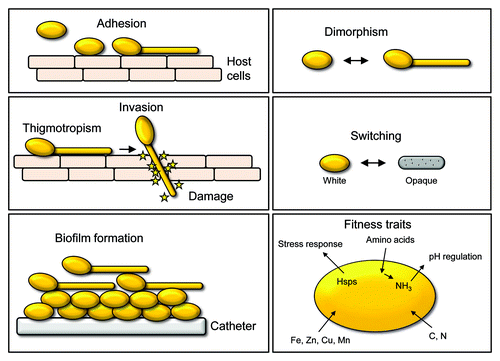Figures & data
Figure 1. An overview of selected C. albicans pathogenicity mechanisms. Yeast cells adhere to host cell surfaces by the expression of adhesins. Contact to host cells triggers the yeast-to-hypha transition and directed growth via thigmotropism. The expression of invasins mediates uptake of the fungus by the host cell through induced endocytosis. Adhesion, physical forces and secretion of fungal hydrolases has been proposed to facilitate the second mechanism of invasion, i.e., fungal-driven active penetration into host cells by breaking down barriers. The attachment of yeast cells to abiotic (e.g., catheters) or biotic (host cells) surfaces can give rise to the formation of biofilms with yeast cells in the lower part and hyphal cells in the upper part of the biofilm. Phenotypic plasticity (switching) has been proposed to influence antigenicity and biofilm formation of C. albicans. In addition to these virulence factors, several fitness traits influence fungal pathogenicity. They include a robust stress response mediated by heat shock proteins (Hsps); auto-induction of hyphal formation through uptake of amino acids, excretion of ammonia (NH3) and concomitant extracellular alkalinization; metabolic flexibility and uptake of different compounds as carbon (C) and nitrogen (N) sources; and uptake of essential trace metals, e.g., iron (Fe), zinc (Zn), copper (Cu) and manganese (Mn).

